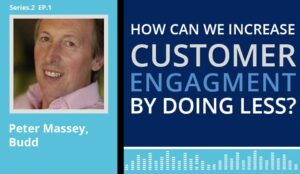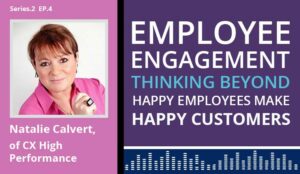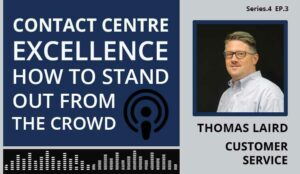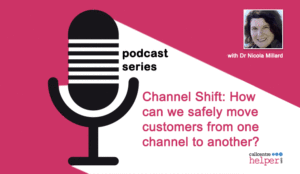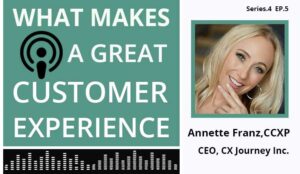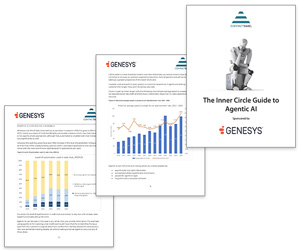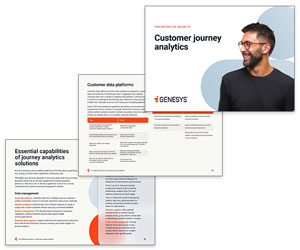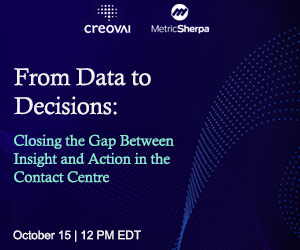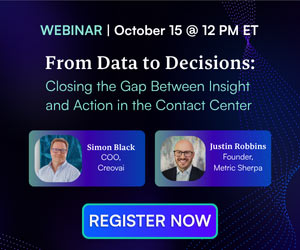
The Contact Centre Podcast: Episode Seven
In this episode, Peter Massey of Budd highlights where your customer engagement strategies might be going wrong, giving plenty of advice along the way of how to improve.
As part of our discussion, Peter Massey of Budd discusses where your customer engagement strategies might be going wrong, giving plenty of advice along the way of how to improve.
To listen to the podcast directly from this web page, just hit the play button below:
The Contact Centre Podcast – Episode 7:
How Can We Increase Customer Engagement By Doing Less?
This podcast was made possible by our sponsor, Genesys.
Podcast Time Stamps
- 2:10 – Stop Doing Dumb Things to Your Customers
- 6:29 – Examples of Disengaging Practices
- 13:59 – The Best Service is No Service
- 21:58 – Using AI for Customer Engagement
- 30:55 – Customer Engagement Strategies
Here is a Transcript to the Podcast
Charlie Mitchell: You’re quite well known to our listeners who have tuned into our webinar program for your customer service slogans, one of which is “Stop doing dumb things to your customers.” How can organizations find out where they are disengaging with customers?
Peter Massey: Well, I think the “How do we stop doing dumb things to our customers and our people?” is a phrase now that’s quite widely known, as you say. The dumb things are not necessarily because it’s a dumb company. Large organizations are complex structures and that necessarily brings in some compromises about the way that things work. Problem is that quite a lot of the things that we do in supporting our customers, be that in sales or service situations, is not useful to them and it’s not useful to the company either. So, those are the things that we call dumb things. You know, if it’s an irritant to the customer, an irritant to the company, why they’re happening at all, and it behoves the company to work on getting rid of the root causes of why those things happen.
So when it comes to how can organizations find out where they’re disengaging, it really is pretty simple. The approach that we start with in our work is to look at why customers get in touch at all. What is the customer intent? The classic of that is logistics or retail would be something like where’s my stuff? And where’s my stuff is a situation where neither the company wants to have to handle that call and the customer certainly didn’t want to make the call or the contact in the first place. So organizing your customer intents and understanding your customer intents really, really well is the first step. And after you’ve organized those intents and you know what they are, we use, as I’ve already mentioned here, an approach about irritants.
We take a very simple two-by-two which is one dimension is the customer. The other dimension is the company. And if you imagine value an irritant for the company, value an irritant for the customer, you end up with those four quadrants, and the quadrant which is irritant to customer, irritant to company is where the dumb stuff is. The quadrant where value to company and value to customers is, is where you want to put your personalized assistance or you want to put your resources to help customers in the maximum you can.
The other two quadrants are interesting because if there is value to the customer but an irritant to the company, then that is the quadrant where you can automate, use self-service, et cetera, and that’s because there is a value, and the customer will work through your self-service. The quadrant where there is no value to the customer but there is a value to you, typically that can be a regulatory letter, for example, or something like that where the company’s got to do something but the customer is not necessarily seeing any benefit in it. That’s the quadrant where you would simplify as much as possible, but not try to automate because the customer’s getting no benefit and is not going to work through the automation in that way.
So a couple of examples I’ve given, where’s my stuff, is a classic example in retail, in the irritant quadrant. A classic example is a change of address. I want to change my address or I want to change my details. You can, depending on the strategy you have for that customer segment, decide to put that in any of the four quadrants. And it does come down to how you do it and what your approach to it is. So some companies would say change of address is valuable to the customer because they lose the service otherwise and it’s valuable to the company because it’s an upsell opportunity.
Other companies will turn around and say, “Well it’s an administrative task that the customer doesn’t want to do. So how can we simplify it as much as possible? We want to keep the data straight.” So the approach to your question, how can organizations find out what they’re doing to disengage customers is really that very simple, what are the intents, what does the value irritant grid look like? Then what are you going to do about that? And that’s the fundamental of that stop doing dumb things approach.
Charlie: And I think it’s particularly interesting there that that approach seems to have been developed through practice. And I was wondering if you have any examples which would particularly stick in the memory of organizations doing something dumb to their customers but maybe not realizing in going through that process?
Peter Massey: Yeah, I mean there are so many, I mean typically we’ve worked in every sector and in every sector you find that something in the order of 40 to 60 to even 80% of contacts can fall into that dumb category. And retail is particularly like that, you’re sometimes looking for what people call a perfect order, where a customer knows what they want, they can find it, they can order it, they don’t have to make any contact. And actually a lot of contact in retail or logistics is not necessarily dumb, but it’s an irritant to customer and to company.
If I think of it in terms of, say, telcos, originally this approach to value irritant we developed way back in the ’90s when Mercury One2One started and they were overloaded with calls and we were starting to look at which types of call could be eradicated by being more sensible upstream.
And I think the whole basis for the approach still works within telcos very, very strongly. Through the years 2009 through to about 2013 we ran a blind benchmark for the UK telcos, taking their data for contact rates, blinding it and then showing them where they were up and where they were down in prepay, post-pay and online. And actually trying to drive the behaviours of the organization. And, of course, it’s not the contact centre director who’s creating the contact, it’s upstream somewhere in the product development, the marketing messages, the online information, et cetera. In which if they are not set up to win, they fail to give the customer what they want in the circumstances that occur. So, what one is really trying to do as a contact centre director is to work upstream and get the rest of the organization to really understand contact rates and understand their part in eradicating them.
And that is the fundamental, has been ever since we’ve been doing this approach, it’s the fundamental of what a contact centre director does. It’s not being brilliant at contact, that is in many ways what a contact centre director’s job was. A director’s job today is to be brilliant at understanding why contact occurs and using the contact that occurs to understand that and to dig it deeply and to put the data analytics around it. And then proving to his colleagues that it’s worth them doing something about it, rather than just he being seen or she being seen as the problem. The contact rates have gone up; that’s not the contact centre director’s fault. If the contact rates have gone up, whose fault is it? And being really, really clear where that lies and that’s where detailed data behind those customer intents becomes absolutely fundamental.
Charlie: I do think that aligning customer communications point is very important in terms of engagement, particularly because maybe the contact centre will send the customer a letter in a week. The research team will send an email in the same week and marketing might send an SMS in the same week. So, if you have all these communications that the customer is completely bombarded by, they will eventually tune you out.
Peter Massey: Yeah, I mean companies are trying very, very hard now to centralize their data and understand the contacts that they cause themselves, the proactive contacts. And I think that has improved, but it’s still a … It’s an ever ongoing battle. It’s not one that goes away. What is clear is that the technologies have moved on and this is where cloud computing has helped a lot, the use of APIs and so forth to link systems and the ability to see, not necessarily to have a complete view, but to have a fairly close to complete view of what’s happening to a customer in the journey that they’re on.
The difficulty is that the organization is not necessarily built around that journey. It’s built in parts from reaching customers, selling things to customers, supporting customers, billing customers, et cetera, et cetera.
And so the challenge is to make sure that the senior management is pulling together that picture around the customer’s journey and enacting business rules for contact or for support which make sense to the customer. I’m a great believer in looking at the customer’s hierarchy of support. Very often we’re looking at the way that the company wants to see support. We need to be brilliant at handling contact. We need to be brilliant at online, we need to look at things that way. Well, actually a customer looks at it the other way around. They say, “Well, I really want to do nothing.” For many, many situations. There are some situations when they do want a contact, for, say, reassurance on a complicated purchase or a highly valuable exercise, a pension, or a car, or something like that. They may want to have a contact, but for the majority of the time they want to keep it as simple as possible and do very little.
If not, then a lot of people fall into the category of wanting to do something themselves. Just show me how to do it and I’ll do it really well. Do it with assistance. I may need somebody on the phone for part of what I’m doing or I need to get you to do it, I know I want the company to do it for me. So for example, if I think of it as a great company for this approach is Nest, you know, the thermostats and the smoke alarms. There’s very little to do when you buy a Nest, but there is quite a lot of … Somebody, the electrician has got to physically wire it in or do something in particular.
Well, the do-nothing part of that is that everything is labelled, there are little labels in there, there are screws and screwdrivers that fit. There are all sorts of things that are there to make the minimum amount of work for the customer, to help the electrician do what they’re going to do. Or a practised DIY-er could do it themselves. And then if you need help and you go into the help function, you’re led through into that from the device and through the mobile app, then the videos that are there are interactive. They cover all of the circumstances that you might require and they’re extremely comprehensive in that they make you feel like you’re quite capable of doing something which otherwise you would feel you couldn’t.
So you’re getting assistance and you’re not necessarily having to get Nest, the company, to do anything because they’ve planned and designed the product from scratch to be, what’s the word, not only tactile and nice to look at and that of thing. They’ve planned how to make it possible for an amateur or a DIY-er or an electrician to install this thing and make it work first time. And if it isn’t working easily, if that’s not going easily, then the support levels that are there through the online tools are fantastic. So that’s an example of a company looking through the customer’s hierarchy of needs rather than just thinking about being brilliant at contact when the contact occurs, in that way.
Charlie: I think that’s an interesting point there that you said most customers don’t really want to do anything. And that makes me think to another one of your slogans actually, which is “The best service is no service.” Do you think perhaps over the years that contact centres have started to take this a bit too far by eliminating all of these frictions within the customer journey, so that they’ve forgotten about the importance of customer engagement itself?
Peter Massey: I would disagree that it’s gone too far. There is a 1990s debate we sometimes get into about no contact, but I think that’s a misunderstanding of what no contact is. So, best service is no service is best service is no need for service. In other words, the customer can choose to pick up the phone or send an email or whatever, in their circumstances where there’s value to them, you want to support them in an inappropriate way, be that online or be it with people. But we’re not suggesting that all conversations should be eradicated. But for the majority of companies we’re nowhere near eradicating the dumb stuff and therefore there’s a lot of cost absorbed and a lot of people’s time and frustrations absorbed in that, in those dumb contacts.
So that’s both the energy of the customer and the energy of the agent. Whereas if you’ve got to the situation where you’ve removed as much as you can or continue to remove as much as you can in the way that Amazon has worked on this for 25 years-plus, it frees up the resources. It gives you the head room to really focus on engagement when it’s appropriate. So there’s no point trying to cross-sell on a call where you didn’t get resolution of a customer’s problem. That’s the classic bad customer engagement. There is every point of talking to customers about what else they could do with the product after you’ve solved a problem, or when they’ve made an enquiry educating them about the way in which they can do more with the product they’ve got. So it’s about being appropriate.
And again, I go back to that value irritant grid. That’s an easy way of deciding what’s valuable and where it’s valuable and giving yourself some head room by eradicating some of the noise. And when you’ve got that head room you can be much clearer about, okay, what kind of engagement do you want. So, no service doesn’t clash with customer engagement. It’s almost a kind of utility-type situation whereby you need to get rid of the bad stuff, the noise, so that you’ve got the resources to do the good stuff and get a lot more engagement going when you have the conversations.
Charlie: It makes me think a lot of the focus is still on customer journey mapping, and as we go through to improve customer journeys maybe using the value irritant grids. Are enough companies involving other departments in that activity?
Peter Massey: Yes, I think so. Over the last few years, certainly what you’ve seen is a lot of people do think end-to-end in terms of the journeys. As we’ve mentioned a couple of times already, organizations are not structured necessarily around those journeys, although some are and some are moving to that direction. But the problem of an end-to-end journey crossing organizational boundaries is one of the fundamentals of the way organizations are designed. And that’s for the CEO to understand and to redesign at that level because it’s not something that even a senior director can do on his own. When it comes to customer journey mapping, I’m a great believer in understanding those journeys, but at the same time being quite tactical about where are the big pain points and what do they look like, and what you can do to fix them.
So for most businesses that we go into there are so many low-hanging fruit and most of them are known. It’s not that these things are surprises. They’re particularly known by the people who talk to customers all day. And what really is lacking is the ability of the senior management to prioritize and to really attack with some longevity, not just to kind of analyse, right, that’s the big stuff, we fixed a couple of things, off we go. It’s actually putting more of an ecosystem in. We often refer to it as the analogy of building an engine. Most organizations have got the carburettor and the engine block and the oil, and the this, that and the other. What they’ve really got to do is assemble it properly, put some fuel in it and then make it run well. And that engine is an engine for continually understanding customer need, for continually working on improving the root causes and continually working on better engagement from that.
And it’s that stamina factor which often we find is a problem. Some organizations now we’ve perhaps worked with over three generations of management over the last 15 years in the same organizations. And the problem that the customer’s got is still the same. The focus of management changes as senior people move job or take their eye off the ball or just get interested in the next silver bullet. And there are no silver bullets around customer engagement and customer service. It is hard graft, detailed analysis, detailed data, continually working back up the organization to improve what happens for customers and continually lobbying with your peer group to keep their attention on the contact that they can cause if they’re not thinking about that as one of the fundamentals of their job.
So not many logistics directors or marketing directors or sales directors will think that one of the key attributes of their job is to think about customer contact down the line. That’s what they should be doing. And that’s what the best organizations do. And you particularly see that with the start-up organizations, companies that are getting funded, be it in Tech City in London or all over the world. The one thing they’re not thinking about doing is building a big call centre; what they’re thinking about is how do we create absolutely brilliant experience of the product, great support experience online and how do we make sure that we don’t need to build lots and lots of call centres?
And that’s a fundamental that hasn’t changed really over the last 25 years. So whether you’re an Amazon, founded in the mid ’90s and still focusing on contact rates, or you’re a Worldpay that really started to grow in the early two thousands – we worked with them for five or six years then – and focus on what you cause contact by. Or whether you’re a start-up today, it is a fundamental saying, “Nope, we don’t want to build contact. We want to make this experience the best it can be.” And that’s the approach, I think, that a lot of organizations would love to have. There is one problem, of course, if you’re a big organization you have a legacy. Somebody once said, ” God created the world in six days, but he didn’t have a legacy.” And it’s a fresh organization, there’s no legacy data, et cetera, et cetera, in a start-up you can start and aim at where you want to go.
If you’re in a large organization and trying to transform that then I think you’ve got to be really, really, what’s the word? Not aggressive but really focused on contact rates, really focused on communicating with your peer group and really focused on acting outwards from the contact centre using the intelligence of the contact centre, rather than focused inwards into the contact centre. And that to me is the difference between a contact centre manager and a contact centre director, which way do they face? Do they optimize what happens when the contact’s there or do they optimize what happens upstream for the customer so that the contact doesn’t occur?
Charlie: I think one key thing I wanted to pick up on there was using the intelligence that’s stored within the contact centre, as one thing organizations are doing quite a lot now is to use the data through AI. I was just wondering if you could help us understand how organizations are using AI to predict when is best to engage with customers?
Peter Massey: Yeah. I think… I’m not so sure about when they’re predicting when it’s best to engage with the customer. Maybe the question ought to be, how can you use AI to predict when a customer wants to engage with you? The other way around. But nevertheless, if you just take this subject more broadly, there’s a sort of first layer of intelligence which has been there forever and is always underutilized, and that’s what the technicians or agents or people on the frontline know about customers is just so deep and so experienced that any consultant knows, they go in, they’ll go and sit down in the call centre, they’ll listen to calls, they’ll talk to agents and you can find out a lot of the answers and you can find out a lot of the why are things not being fixed?
Quite a lot of agents who’ve been there a few years have seen quite a few generations of attempts at fixing things as well. So, there is a native intelligence in the call centre, which doesn’t always get used. Two reasons. One, culturally, so does the senior management really value, plunder that intelligence so that it’s brought to bear? And secondly is that often it’s at scale. So, actually trying to scale up that intelligence means we end up sort of boxing, or scoring, or trying to bring that richness of the data into some sort of structured data. And that in itself can remove some of the value.
So, the customer experience industry that’s grown over the last 10 or 15 years is something which I think is now at risk. I think there are armies of people actually scoring NPS for this and that and the other and doing all sorts of things, but not necessarily extracting from that information the intelligence that the agents have and that you can get from a conversation with frontline staff. And that leaves a hole, which I think AI is going to significantly address.
Let’s just go back from that then and say, okay, will AI replace or enhance the intelligence of what the agents know? The answer is, yeah, it can do but, again, if you’re going to apply AI and start to try and pilot things and so on and so forth, the start point ought to be how do you engage your frontline staff who know what customers want because they will have, whether you’re doing speech analytics or whether you’re doing chatbots or you’re doing looking for trends in data, you need people to help that AI, to program the AI. And I’ll put a caveat on that that maybe this year, next year, sometime in the next couple of years we’re going to see a level of AI which is different from that, and which can program itself, but that’s early doors yet. The majority of what people are talking about as AI today is either decision tree-type learning – you know a person can work out decision trees, if this, then that, build up those decision trees and then have the AI programmed to match those decision trees.
Or it’s machine learning, which is vast amounts of data from which the patterns can be extracted by the AI. The third level of AI, some people call it unsupervised AI, where the AI tool can watch what people do, look at what the best behaviours and patterns are, look at the best use of knowledge and then extract that information for you and start applying it. That’s really where it’s going to get entertaining. I think we’re on the cusp of that now. There are a number of companies, there’s one, PolyAI, which I’ve been helping in London, which is now at that point where AI will lead to a different stage.
At the moment everybody’s claiming AI, but in practice what we’ve got is copy a person or have it programmed by a person, or plunder a shed-load of data to do the machine learning side of it, and that’s a different kind of approach. So again, back to the topic being intelligence. You’ve got frontline intelligence, you’ve got three different levels of AI, at least. At the moment what you fundamentally want to learn with the AI, the agents probably already know. And my advice is always to get the analysts together with the frontline staff because you can accelerate very quickly the way they program the tools and the way they get the juice out of the AI, and it’s that people plus humans which matters. And part of that is that the people concerned do understand the detail. You can’t work with AI without understanding detail.
And I think that’s a fundamental of the way you use it. Whether you’re talking about RPA or speech, or AI applied to analytics more broadly. So, that that’s sort of one end of intelligence. I think what I’m seeing is that there’s a lot of people playing, a lot of people piloting things, people learning. And I think that’s the right approach because, at the end of the day, the AI that we’ve played with over, God knows, back to 2004 actually – we did some experiments with the BBC. Every experiment we’ve ever done has proven that the quality of the analyst is more important than the quality of the tool. So building up analytical skills in your workforce and in your senior managers is one of the real fundamental challenges of this because AI is not just going to challenge the way we do work. It’s going to challenge the way we improve work and the way in which we look at our businesses.
One of our clients recently showed me a very interesting slide that they’re using, which was looking at the analysis they get as hindsight, insight or foresight. A lot of the data that they’re getting is hindsight data, it’s historical data. And the insight layer, what’s that historical data telling us? There’s a lot of work manually to try and extract that, but across large workforces, that’s a real challenge to upskill your managers to be able to extract insight. When you get to foresight, what’s the intelligence telling us we ought to do in future to engage better or to improve the way we operate, or to do those kinds of things? Then the skill levels of people in a lot of contact centre environments have got some way to go. So that’s kind of an upskilling trend that’s really, really important, and I think a lot of people are working on.
What’s already worked and I think has been really a big improvement is that there’s been some democratization of some of the dashboards. Things like Power BI or Tableau or Qlik have started to be adopted around a lot of large-scale organizations and they’re allowing analysts in all sorts of corners of the business to build some really good dashboards, some really insightful data. So whether they are using AI or not, they are able to maximize the insight that can be extracted from the data through better visualizations, better cross-calculation from different sources. The quality of dashboards that people are producing has gone up considerably just because there’s more of it going on. And then the last bit is the use of those dashboards in contact centre operations. There are some really good set-ups now, where the daily running of a contact centre or – this applies to back office as well – there are people running dashboards and process boards effectively. How do we run the centre today? What have we done yesterday? How did that improve what we did? What did we learn from that? What are the opportunities going forwards? What’s our focus this week? Where our KPIs at? Et cetera, et cetera. And building that into a standard set of processes which can be run as operational boards, touchscreens, that kind of thing, huddles and all the rest of it.
And those kinds of democratization of the data along with an operational focus for its use in order to get insight and foresight working from the hindsight data is a sort of fabulous shift, I think, in terms of the quality of the way that some contact centres are operating.
Charlie: Yeah. I think it’s really interesting from what you’ve said there, how AI is not just going to be plug-in and play systems that will only affect the customer. How much in the future it will probably change the dynamic of the contact centre all the way down to advisors and using their own analytical skills, which is something I don’t think has ever been really considered that much. Just moving on now in terms of, you mentioned there one really interesting organization who had this engagement strategy of using insight and foresight from hindsight data through AI. Are there any other companies that have really impressed you with their customer engagement strategies moving forward?
Peter Massey: Yeah. It’s always a common question, really, who do you follow? What do you think is good? What does good look like? It is always an interesting one. The couple of examples perhaps I would quote, one is DVLA, very interesting organization, for car tax and driving licences and stuff like that. And the terrific amount of volume, and a lot of political sensitivity, et cetera, et cetera. But they have done some really, really basic good staff around using user experience labs to thoroughly understand what happens when somebody tries to fill in a form online, or on a bit of paper, or whatever it might be. And I frequently hear people talk about renewing their car tax as being a pleasure, it’s like three or four screens, bang, bang, bang, the information is already there. And that is, I think, an illustration of what large-scale organizations can do if they really put their mind to it.
So DVLA is one. I would quote the other one I quoted earlier on about Nest, but another one I would quote about in terms of simplicity is AWS. Obviously Amazon is a classic and is behind the whole story of best service is no service, and they’ve focused on the retail environment, they’ve focused on the contact rates for 25 years and never let up, which is a brilliant example of stamina. But AWS, which has obviously grown out of Amazon and is absolutely vast. If you look at the AWS site and look at how easy it is to get assistance with what does a product do? And how does it do it? And how to configure it and so forth. Again, there’s a huge amount of educational material in there, but the simplicity with which you can download some of the stuff is quite staggering.
And I think this is going to be really interesting with the whole contact centre market because AWS and Google are now starting to focus on the contact centre market and are bringing things to market which are very, very easy to deploy, hugely capable and hugely connected. And so I think we’re going to see some really interesting things over the next six to 18 months about how people start procuring their contact centre and the speed with which they start to apply latest-generation AI in that environment. As an illustration of a company that’s very good with customer engagement, I think AWS is a fascinating website to have a look at and see what you can learn about some highly complicated products. But even if you’re not technical you can see an awful lot around it. So those are some examples.
I probably, if I looked at it the other way around and said, okay, where are we still seeing a lot of struggling? The financial services industry struggled with customer engagement and customer experience for a long time, and spent vast amounts of money on it. But you’re starting to see companies coming in now which are deemed by their customers to be much more effective. I’m a long-term First Direct fan and user of, but I’ve just opened a Starling bank account for the business because HSBC is pretty clunky. And of course it immediately appeals to me to go like, well, hang on a minute, what do they do that First Direct don’t do in a banking environment? Because most of my banking I’m now doing on a Monzo card, because the Monzo card is way better than the First Direct mobile option.
And so there’s this kind of like, ooh, hang on a minute. There’s a whole set of FinTech companies which are coming on board with apps which are much more functional, much more useful, but most of all easy in that sort of way. So I think there’s some real challenges for the financial services industry in that respect.
Charlie: You’ve mentioned Monzo there, that’s quite a new company. And maybe that comes back to your point earlier of these start-ups have a more of a hold than the established organizations because they have less silos, because it’s a newer business and it’s a newer organization who are the ones that do it well, especially.
Peter Massey: Yeah. Absolutely.
Charlie: Yeah. The DVLA example with the car tax was one that I had recently, and yeah, it was one of the most easy experiences I’ve ever had. Yeah, it was, that particularly struck a chord with me.
Peter Massey: You know, if you’re the CEO of a large-scale organization then this sort of digital transformation malarkey that’s bandied around the whole time is really scary. And you see people spending hundreds of millions and more on trying to transform processes or transform organizational structures, or cultures, or anything else. And it is really, really difficult because there’s a talent war out there to get the very best people who think like customers think. And actually when you start to look at the people who go to work for the Googles, Amazons, Facebooks and Apples and so forth, their CVs have great reputation on them. But actually one of the key things that they’ve picked up while working for those companies is thinking like customers think.
Jeff Bezos talks about day one, every day is day one. Every day is a start-up. Amazon does not behave like the mammoth organization that it is because it’s totally focused on customers. And what I see in the tech start-ups in London is people with the fancy CVs of having worked in these companies, it’s not that they’ve got a fancy CV, it’s actually they’ve learned to think like customers think and that is not impossible in any large-scale organization, but it really does take focus and it takes stamina. It’s not a quick fix.
Charlie: Absolutely. I think there’s lots of key takeaways for our listeners today. Just as a final question, is there any way that our listeners can catch you on social media if they want to find out more about you and your consultancy, Budd?
Peter Massey: Yeah, sure. To get hold of me, the best bet is probably LinkedIn. See the profile on there, Peter Massey at Budd and also Budd website, I’ll tell you a little bit more as well,
www.budd.uk.com. And yeah, there’s phone numbers and stuff like that on there as well. So we’re always happy to chat to people about what they’re trying to do. We have got quite a lot of material that we send to people when they’re trying to do this themselves. Also happy to support people to do it themselves as well as to be paid to do this kind of thing.
And personally I’m always interested in the challenges that organizations have got. So I spend a fair bit of time on the conference circuit, but also going out to organizations and not doing the sort of paid diagnostic, but just having a look for a few hours with people and discussing with senior management teams what is it that they think they’re trying to do. And helping set some direction on those kinds of things. So, always up to talk to people at either an unpaid as well as a paid level.
Author: Jonty Pearce
Reviewed by: Jo Robinson
Published On: 16th Oct 2019 - Last modified: 26th Sep 2025
Read more about - Podcasts, Charlie Mitchell, Customer Engagement, Customer Management, Genesys, Peter Massey, Podcast





